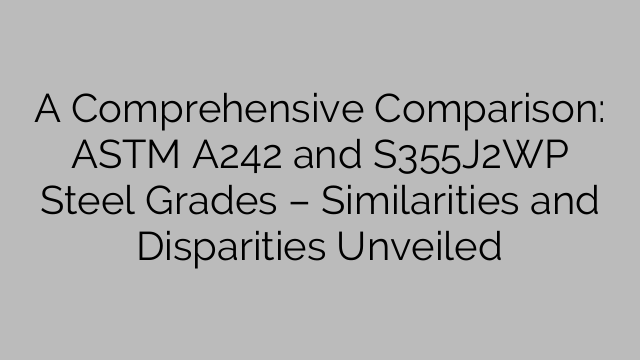ASTM A242 and S355J2WP are two steel grades widely used in the construction industry due to their excellent weathering resistance properties. While they share some similarities, there are also some disparities that make them suitable for different applications. In this article, we will delve into a comprehensive comparison of these two steel grades to explore their similarities and differences.
Starting with the similarities, both ASTM A242 and S355J2WP are popular choices for outdoor structures and buildings exposed to harsh weather conditions, especially corrosive atmospheres. They possess excellent weathering resistance, which allows them to withstand the impact of atmospheric corrosion, including rain, snow, humidity, and even saltwater environments.
Another common feature is their ability to develop a protective oxide layer on the surface when exposed to the atmosphere. This oxide layer acts as a barrier, preventing further corrosion and protecting the underlying steel structure. This natural patina gives these steel grades their unique appearance, making them aesthetically pleasing options for architects and designers.
However, there are some disparities between these two steel grades that differentiates them in terms of their mechanical properties and chemical composition. Let’s examine these differences in more detail:
1. Chemical Composition:
ASTM A242 has a higher carbon content compared to S355J2WP. The additional carbon content in ASTM A242 makes it more resistant to atmospheric corrosion, as it increases the steel’s ability to form a dense and stable oxide layer.
S355J2WP, on the other hand, contains higher amounts of phosphorus, sulfur, and copper, compared to ASTM A242. These elements enhance the atmospheric corrosion resistance of S355J2WP and contribute to its excellent weathering properties.
2. 기계적 성질:
Both steel grades have different mechanical properties that make them suitable for various applications. ASTM A242 has a minimum yield strength of 50 ksi (345 MPa), while S355J2WP has a minimum yield strength of 355 N/mm². This higher yield strength in S355J2WP makes it a stronger and more durable option for structural applications.
Additionally, S355J2WP has better impact toughness and elongation properties compared to ASTM A242. This makes it more suitable for areas prone to high wind loads or seismic activities.
3. Applications:
Due to their similarities and disparities, ASTM A242 and S355J2WP are utilized in different applications. ASTM A242 is commonly used in outdoor structures like bridges, railways, and buildings that require a higher resistance to corrosion. Its higher carbon content and lower yield strength make it ideal for these applications.
On the other hand, S355J2WP is often employed in structural applications that demand higher strength and impact resistance. This grade is frequently used in the construction of cranes, towers, and other load-bearing structures.
In conclusion, both ASTM A242 and S355J2WP steel grades offer excellent weathering resistance properties, making them suitable for outdoor applications exposed to harsh atmospheric conditions. While ASTM A242 provides higher resistance to corrosion due to its increased carbon content, S355J2WP offers better strength, impact toughness, and elongation properties. Understanding their similarities and disparities allows engineers and designers to select the appropriate grade based on the specific requirements of their projects.

